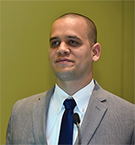Socioeconomic Disparities May Foster “Missed Care Opportunities”
Researchers are shedding new light on some of the possible reasons behind patients’ missed radiology appointments and implications for care


After missing two scheduled MRI appointments at Massachusetts General Hospital (MGH), a patient of Efren J. Flores, MD, finally made it to MGH on her third attempt.
When Dr. Flores, a diagnostic radiologist at MGH, investigated, he found that the patient missed her first two appointments for a very simple reason — phone message reminders left by the hospital were in English, which is not the patient’s primary language.
This led Dr. Flores to wonder how many other patients were in similar situations and weren’t receiving proper health care on a timely basis “because they are falling through the cracks and can’t navigate the healthcare system.”
The incident created an opportunity for radiologists at MGH as well, Dr. Flores said.
With the help of his colleagues, Dr. Flores launched a study to determine whether socioeconomic disparities have an impact on access to radiology and imaging services. In the course of his research — which was presented at RSNA 2015 — Dr. Flores used a different term to describe the event that is typically referred to as a patient “no-show.”
For 5 Tips to Prevent Missed Care Opportunities (MCOs).
“Missed Care Opportunity — or MCO — is a better term,” he said. “It reflects what should be the shared responsibility of providers to engage patients in their health care, rather than blaming the patient and labeling them as ‘no-shows.’”
While there is no shortage of research analyzing socioeconomic disparities in healthcare in general, very little research focuses on how those disparities pertain specifically to radiology, Dr. Flores said.
James Brink, MD, radiologist-in-chief at MGH and the Juan M. Taveras Professor of Radiology at Harvard Medical School, suggested that radiology’s role out of the primary care spotlight could be a factor.
“It could be that radiology isn’t considered to be ‘frontline’ medicine,” Dr. Brink suggested. “It’s considered more consultative medicine rather than primary care, and the battleground for serving underserved areas and ensuring access for underserved communities has been more about primary care.”
Research Spotlights Patient Access to Imaging
Nevertheless, some studies have addressed this issue as it pertains to radiology and medical imaging—not always drawing the same conclusion.
For example, in a study published last year in PeerJ, Afton McNierney-Moore, DO, an emergency medicine physician at the Texas A&M School of Medicine in Corpus Christi, and colleagues examined whether cultural differences and language barriers would adversely affect a patient’s understanding of the risks associated with medical imaging. Examining a study group that included Hispanic and non-Hispanic patients, researchers determined that while the group’s overall knowledge of radiation risk was poor, there was no significant difference between Hispanic and non-Hispanic patients in terms of understanding radiation risk.
A study in the September/October 2015 issue of the Journal of Public Health Management & Practice determined that Hispanic women have lower odds of undergoing mammograms than non-Hispanic white women. Study author Smruti Jadav, MPharm, MS, and colleagues from the University of Texas Medical Center in Houston, concluded that better access to care, education and income, along with improved insurance access would considerably increase breast screening rates among Hispanic women.
In his research, Dr. Flores and colleagues collected data on almost 1 million radiologic examinations at MGH ordered during 2014. Researchers determined that an MCO was the most common reason that patients failed to complete a radiologic examination. Overall, about 5 percent of radiology appointments in 2014 resulted in an MCO.
“We found that healthcare disparities exist in radiology,” Dr. Flores said. Specifically, lower incomes, a primary language other than English, and African-American or Hispanic ethnicity were significantly associated with greater odds of an MCO for a radiology appointment.
“So the first step was to find out if there was a problem and the answer to that was ‘yes,’” Dr. Flores said. “And since there is a problem, there are also opportunities to make it better—to show that radiology cares.”
One of the next steps Dr. Flores took—with the help of medical analytics groups at MGH—was to develop an algorithm or mathematical predictive model based on big data predictive analytics. The goal is to identify patients at risk for MCOs in order to develop interventions that successfully mitigate those missed chances.
While the nature of those interventions has yet to be determined, Dr. Brink said the radiology department at MGH is making this issue a priority.
“We have a strategic planning retreat every year and one of the goals for this year is to respond to the conclusions detailed in Efren’s study,” Dr. Brink said. “One thing we have done recently is to partner with our MGH Center for Community Health Improvement (CCHI), which focuses many activities in areas that Efren has shown are most in need of our help.”
“We’re starting to meet with CCHI to see what kinds of opportunities there are based on our research and how we can collaborate and come up with some solutions,” said Dr. Flores, who serves as the radiology department’s liaison to the CCHI.
“Each imaging exam is a patient encounter, so we really see more patients than any other specialty,” Dr. Flores said. “We need to step out of our reading rooms and see what our patients really need. There are going to be certain things that are beyond our control, but we can do the little things, whether it’s making sure patients get the appropriate prep before a CT or MRI, or helping them coordinate transportation so they get to their appointment on time and home safely.
“These steps add up to doing a better job in providing care,” he said.
5 Tips to Prevent Missed Care Opportunities (MCOs)
- Offer reminder text messages or phone calls in the patient’s preferred language
- Provide procedure preparation instructions and clearer educational materials in various languages
- Allocate advocates who can assist patients with items like healthcare system navigation and transportation to appointments
- Closely collaborate with referring physicians to develop effective solutions based on patient's needs
- 5. Provide greater education to professionals and institutional leaders on the importance of culturally sensitive healthcare delivery
— Efren J. Flores, MD
RadiologyInfo.org Offers Patient Information in Spanish
Important patient information is offered in English and Spanish rel="noopener noreferrer" on the RSNA/ACR website, RadiologyInfo.org featuring detailed, easy-to-understand descriptions of more than 200 radiologic tests and treatments, disease/condition descriptions and screening/wellness topics. The website’s “Your Radiologist Explains” series featuring 81 videos of radiologists explaining common imaging tests in easy-to-understand language, offers four videos in Spanish (Angioplasty and Vascular Stenting, Vascular Access Procedures, Head CT and Contrast Materials), with more in development.